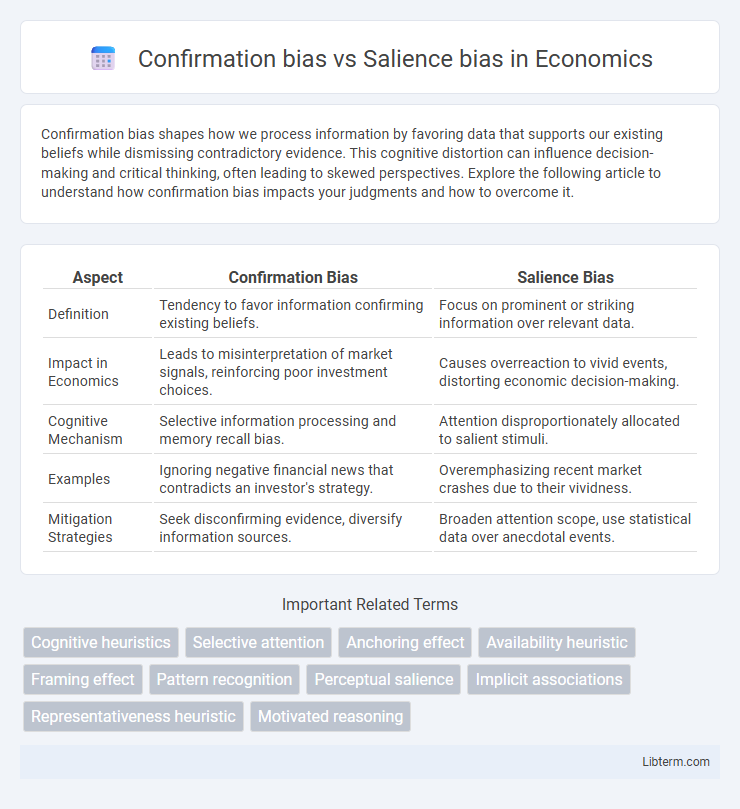Confirmation bias shapes how we process information by favoring data that supports our existing beliefs while dismissing contradictory evidence. This cognitive distortion can influence decision-making and critical thinking, often leading to skewed perspectives. Explore the following article to understand how confirmation bias impacts your judgments and how to overcome it.
Table of Comparison
| Aspect | Confirmation Bias | Salience Bias |
|---|---|---|
| Definition | Tendency to favor information confirming existing beliefs. | Focus on prominent or striking information over relevant data. |
| Impact in Economics | Leads to misinterpretation of market signals, reinforcing poor investment choices. | Causes overreaction to vivid events, distorting economic decision-making. |
| Cognitive Mechanism | Selective information processing and memory recall bias. | Attention disproportionately allocated to salient stimuli. |
| Examples | Ignoring negative financial news that contradicts an investor's strategy. | Overemphasizing recent market crashes due to their vividness. |
| Mitigation Strategies | Seek disconfirming evidence, diversify information sources. | Broaden attention scope, use statistical data over anecdotal events. |
Understanding Confirmation Bias and Salience Bias
Confirmation bias refers to the tendency to favor information that confirms preexisting beliefs, leading individuals to ignore contradictory evidence and reinforce their viewpoints. Salience bias occurs when people focus disproportionately on the most noticeable or emotionally striking information, often overlooking less obvious but relevant details. Understanding these cognitive biases is crucial for improving decision-making by recognizing how selective attention and preference for familiar information distort judgment and perception.
Defining Confirmation Bias
Confirmation bias is the tendency to search for, interpret, and remember information that confirms one's preexisting beliefs or hypotheses, often leading to selective evidence gathering and distorted decision-making. It contrasts with salience bias, which causes individuals to focus disproportionately on prominent or emotionally striking information, regardless of its relevance. Understanding confirmation bias is crucial for improving critical thinking and minimizing errors in judgment influenced by biased information processing.
Defining Salience Bias
Salience bias occurs when individuals focus disproportionately on prominent or striking information, ignoring other relevant data. Unlike confirmation bias, which involves seeking information that confirms preexisting beliefs, salience bias distorts judgment by emphasizing vivid or emotionally impactful details. This cognitive distortion often leads to skewed decision-making, as less noticeable but crucial facts are overlooked.
Key Differences Between Confirmation Bias and Salience Bias
Confirmation bias involves the tendency to search for, interpret, and remember information that confirms one's preexisting beliefs, leading to distorted decision-making. Salience bias occurs when individuals focus disproportionately on the most noticeable or emotionally striking information, regardless of its relevance or accuracy. The key difference lies in confirmation bias reinforcing existing beliefs, while salience bias emphasizes attention toward prominent stimuli that may skew perception.
How Confirmation Bias Influences Decision-Making
Confirmation bias significantly impacts decision-making by causing individuals to favor information that confirms their preexisting beliefs, resulting in selective gathering and interpretation of evidence. This cognitive distortion leads to ignoring contradictory data, reinforcing erroneous conclusions and limiting objective analysis. In contrast, salience bias affects attention by emphasizing prominent or emotionally striking information, but confirmation bias specifically deteriorates reasoning processes by anchoring decisions to biased mental frameworks.
The Impact of Salience Bias on Perception
Salience bias significantly distorts perception by causing individuals to disproportionately focus on the most noticeable or emotionally striking information, often ignoring less obvious but relevant data. This cognitive distortion can lead to skewed judgments and decision-making, as attention is diverted to vivid events or features rather than a balanced evaluation of all available evidence. Understanding how salience bias shapes perception is crucial for mitigating its impact in fields such as marketing, risk assessment, and behavioral economics.
Real-World Examples of Confirmation Bias
Confirmation bias often manifests in financial markets where investors seek information that supports their existing beliefs, ignoring contradictory evidence, leading to poor decision-making and losses. In politics, voters might selectively consume news that aligns with their views, reinforcing partisanship and polarizing public opinion. Real-world examples include traders holding onto losing stocks due to confirmation bias and social media users engaging in echo chambers that amplify misinformation.
Salience Bias in Everyday Life
Salience bias causes individuals to focus disproportionately on the most noticeable or emotionally striking information, often leading to skewed decision-making in everyday life. This cognitive bias makes vivid, recent, or dramatic events more memorable, overshadowing less conspicuous but equally important facts. Understanding salience bias helps mitigate errors in judgment by encouraging broader information evaluation beyond what immediately captures attention.
Overcoming Confirmation and Salience Biases
Overcoming confirmation bias requires actively seeking diverse perspectives and contradictory evidence to challenge preexisting beliefs and reduce cognitive distortions. Addressing salience bias involves broadening attention beyond the most noticeable or recent information by systematically analyzing less prominent but relevant data. Implementing structured decision-making processes and critical thinking practices enhances awareness and mitigates the influence of both cognitive biases in judgment and decision-making.
Conclusion: Navigating Cognitive Biases for Better Judgment
Confirmation bias and salience bias both distort decision-making by reinforcing preexisting beliefs or highlighting overly conspicuous information, respectively. Recognizing these cognitive biases enables individuals to critically evaluate evidence and avoid skewed perceptions. Effective judgment requires conscious efforts to seek diverse perspectives and prioritize objective data over intuitive but biased impressions.
Confirmation bias Infographic

 libterm.com
libterm.com